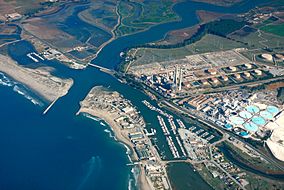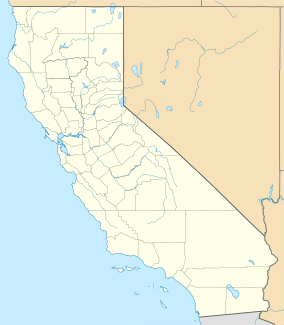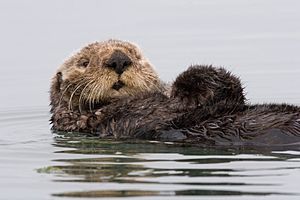Elkhorn Slough facts for kids
Elkhorn Slough is a long, narrow arm of the sea, about 7 miles (11 km) long. It is located on Monterey Bay in Monterey County, California. This special place is California's second largest estuary. An estuary is where freshwater from rivers mixes with saltwater from the ocean.
Elkhorn Slough is also the first "estuarine sanctuary" in the United States. This means it is a protected area for scientific research and education. The town of Moss Landing is right at the mouth of the slough.
The slough has the biggest area of tidal salt marsh in California outside of San Francisco Bay. It provides a home for hundreds of different plants and animals. More than 340 types of birds live here! Since 2018, it has been recognized as a protected Ramsar site, which is a special wetland of international importance.
Contents
History of Elkhorn Slough
The name "Elkhorn Slough" comes from the tule elk. These elk used to live in this area. Sadly, they are no longer found here.
Long, long ago, Elkhorn Slough was part of a river valley. This valley was carved out by water flowing into Monterey Bay. Around the mid-1800s, Elkhorn Slough was a small branch of a much larger river system. This river system flowed into the Pacific Ocean north of Moss Landing.
In 1909, big winter storms changed the path of the Salinas River. It moved to its current spot south of Moss Landing. Elkhorn Slough stayed connected to the old river channel. Then, in 1946, jetties (long walls) were built at the Moss Landing Harbor. This created a direct link between the Pacific Ocean and Elkhorn Slough. After this, the salt marshes in the slough began to change. The slough slowly became the stable estuary we see today.
Where Does the Water Come From?
The main source of freshwater for Elkhorn Slough is Carneros Creek. Other smaller waterways, like McClusky Slough to the north and Moro Cojo Slough to the south, also bring in freshwater.
Protecting Elkhorn Slough
A lot of land around Elkhorn Slough is protected. Out of about 45,000 acres (18,210 hectares) in the watershed, over 8,000 acres (3,237 hectares) are kept safe. Many different groups own and manage these protected lands.
Conservation Groups
The Elkhorn Slough Foundation is the biggest private landowner in the area. They protect almost 3,600 acres (1,457 hectares). The Nature Conservancy was one of the first groups to buy land here. They started protecting the slough's habitat and wildlife in 1971. They later transferred much of their land to the Elkhorn Slough Foundation.
Special Protected Areas
Elkhorn Slough has several special protected areas:
- Elkhorn Slough State Marine Reserve (SMR): This area covers about 1.48 square miles (3.83 square kilometers). It protects all marine life within its borders. Fishing and taking any living marine resources are not allowed here. The California Department of Fish & Wildlife helps manage it.
- Elkhorn Slough State Marine Conservation Area (SMCA): This area is smaller, about 0.09 square miles (0.23 square kilometers). It also protects marine life. In this area, some types of fishing are allowed, but only with a hook and line. Clams can be taken in a specific spot on the north shore.
Both the SMR and SMCA were created in 2007. They are part of a bigger plan to protect California's coastline.
Elkhorn Slough National Estuarine Research Reserve
This reserve is one of 28 similar places across the country. These reserves are like outdoor classrooms and laboratories. Scientists use them to study estuaries, and people can visit to learn about them.
Other Protected Lands
The Moss Landing Harbor District and the Monterey County Parks Department also protect land here. The Moss Landing Wildlife Area protects land north and west of the slough. The Moro Cojo Slough State Marine Reserve protects a similar wetland area nearby.
Amazing Habitat and Wildlife
Elkhorn Slough is one of California's largest estuaries. It provides a vital home for over 700 different species. These include water mammals, birds, fish, and many tiny creatures without backbones (invertebrates). It also has many types of algae and plants.
The slough is famous for having the largest group of sea otters in California. You can often see them floating on their backs! It's also home to rare animals like the Santa Cruz long-toed salamander (an endangered species) and the California red-legged frog (a threatened species). The sea otters here show how well they can live in estuaries. They might even be a model for how sea otters used to live in San Francisco Bay.
Many creatures live in Elkhorn Slough all year. These include plants like pickleweed and eelgrass. You can also find oysters, gaper clams, and longjaw mudsucker fish. Important visitors come seasonally, too. These include migrating shorebirds, more sea otters, and even sharks and rays. The slough has different types of habitats, like muddy areas and tidal creeks. You might also see wildflowers like the yellow mariposa lily.
Helping the Slough Recover
Conservation groups are working to fix problems caused by human activities. They want to prevent further damage to the ecosystem.
Restoring Marshes
In 2010, a steel wall called a "weir" was built at the mouth of Parson's Slough. This is a branch of Elkhorn Slough. The weir helps reduce erosion (wearing away) of the marsh. This erosion was caused by digging in the Moss Landing Harbor and changing the path of the Salinas River. Many groups worked together on this project.
Another project is the Hester Marsh Restoration. This project started in 2010. Many other salt marshes in Elkhorn Slough might be underwater in 50 years. At Hester Marsh, they are building up the marshland. This helps create a healthy salt marsh ecosystem that can survive.
Fun Things to Do at Elkhorn Slough
Many people enjoy visiting Elkhorn Slough. You can go hiking and watch birds. Kayaking and stand-up paddleboarding are also very popular activities on the water.
From the water, you can see amazing wildlife. Look for sea otters, sea lions, seals, brown pelicans, American avocets, cormorants, egrets, and terns. It's a unique way to see how animals use the slough. Remember to always keep at least 100 feet (30 meters) away from wildlife to keep them safe.
The Elkhorn Slough National Estuarine Research Reserve and the Elkhorn Slough Foundation help manage the area. They offer public access with about 5 miles (8 km) of trails. There's also a Visitor Center and chances to volunteer.
The nearby Moss Landing Wildlife Area has 728 acres (295 hectares) of salt ponds and salt marsh. Some activities are allowed here, but they are limited.
If you like fishing, you can catch finfish with a hook and line in the conservation area. Clams can be taken only on the north shore of the slough. However, it's important to know about fish safety. The California Office of Environmental Health Hazard Assessment has a special health warning for fish caught in Elkhorn Slough. This is because of higher levels of mercury and PCBs. For children aged 1-17 and women aged 18-45, it is advised not to eat leopard sharks and bat rays caught here.
California's marine protected areas encourage fun and learning about the ocean. Activities like kayaking, diving, snorkeling, and swimming are usually allowed.
The Moss Landing Harbor District manages the waterways of Elkhorn Slough. They also own Kirby Park, which is at the upper end of the slough. Kirby Park has a small boat launch and parking. There's also a trail nearby that is easy for wheelchairs to use, letting everyone get close to the water.
Studying the Ocean
Scientists are watching the marine protected areas along California's coast. They want to see how well these areas are working to protect ocean health. Similar studies in other protected areas have already shown that fish are getting bigger and there are more of them. This helps us learn more about keeping our oceans healthy.
Images for kids





